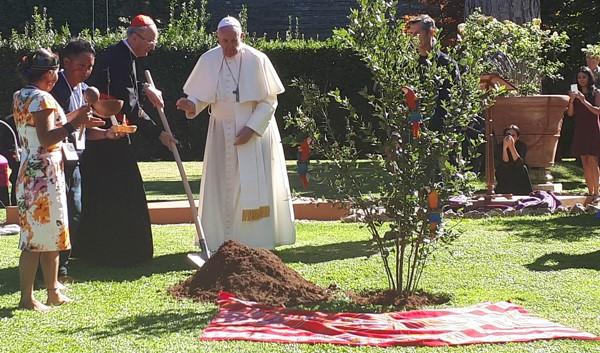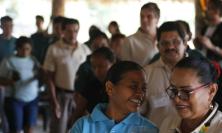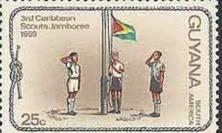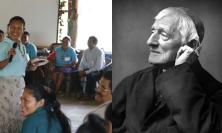‘You might think that the Synod for the Amazon has nothing to do with you, but one out of every five glasses of water that you drink comes from the Amazon!’ Mauricio López of the Pan-Amazonian Ecclesial Network shared his hopes for the Synod of Bishops for the Pan-Amazon Region with Thinking Faith earlier this year, and explains why this is such an important moment in the life not just of Amazonia, but the whole Church.
It’s like a mosaic – there is some unity in it, but it’s only possible to appreciate the beauty of that unity if you can understand and identify the diversity.
These words describe the pan-Amazon region, the unique part of the world that will be the focus of the Special Assembly of the Synod of Bishops which takes place in Rome from 6-27 October 2019. The description comes from a man who knows the territory as well as anyone: Mauricio López, Executive Secretary of the Pan-Amazonian Ecclesial Network – REPAM (Red Eclesial Pan-Amazónica). He visited London in May 2019, and spoke to Thinking Faith about the potential for the Synod to affect the Amazonia and the rest of the world.
It is important to begin by noting the complexity of the territory. ‘We’re talking about 9 countries, with different cultural backgrounds and state structures – that’s already a huge challenge’, says Mauricio. ‘33 million people live in the pan-Amazon region; 3 million are in indigenous communities. In those communities you have 400 different indigenous nationalities, using 200 different languages, which come from 50 main linguistic origins. And then you also have the indigenous peoples who are in voluntary isolation, uncontacted – in the world, these might number 150 groups or families and of those, 140 are probably in the Amazon region. They represent a huge challenge to how we understand other ways of living.’
Given that it is so deeply characterised by diversity, then, why is it so important to have a Synod for the pan-Amazon region? ‘We’ve come together because the threats that the indigenous communities and the excluded peoples are going through have been increasing and there is no way of responding to it in a fragmented way. Agribusiness – the production of soybeans, rice, palm oil – and extraction: this is directly impacting on the biodiversity of the region, but also on the lives of the people who live there. There is a lot of violence, of pushing people out of their territories. Much of the time this is linked with the interests of the governments and corporations from elsewhere. This is a really big issue. All of that helps us to understand why this really needs to be seen as one territory, and the response ought to be a communal response, at least from the Church perspective.’
The fact that this is a territorial synod, covering an area that takes in only parts of nine countries and seven episcopal conferences, rather than a regional one, must not be overlooked: ‘it is a message from Pope Francis, which is directly linked with what he says in Laudato si’ [§38]: that there are two main lungs for the planet, the Amazon and the Congo basin. He is trying to bring a new category into the discussion about how the Church needs to respond, which goes beyond traditional structures. It is not about episcopal conferences, it is not even about a region as such, it is about a biome. When we deal with the urgency of the future, a social and environmental crisis, we need to go beyond our own structures and find new and creative ways of responding to it.’
Mauricio considers an emphasis on statehood in the Amazon in particular to be difficult because it does not speak to the reality of the territory, in terms of everyday experience – ‘Amerindian people in Guyana often feel closer to people in other countries, especially Brazil, than to other people of their own country’ – or its geography and history. ‘National states have failed for decades to understand the importance of the pan-Amazon territory for their own identity. For example, I live in Ecuador, and the Ecuadorian Amazon region only accounts for 1.5% of the total of the pan-Amazon territory, but in fact it is half of the territory of the country, so it’s a huge proportion. The same is true for Peru, Venezuela, Bolivia, Guyana. Guyana has a very tiny coastline, and the population is mostly located there, but pretty much the rest of the country, 85-90% of the total territory, is part of the pan-Amazon biome. Some decades ago, the idea behind the building of our national identities was to see the Amazon biome as a “backyard”, this forgotten piece of land that we had to conquer or bring civilisation to, a no-man’s land which we had to take over to make it productive. I think now we are understanding it as the main square, because of its richness and diversity!’
This richness has a biological dimension, of course – it is well attested to that the pan-Amazon region is a source of water and oxygen for the world, and it is estimated that a third of the planet’s flora and fauna have their origins there – but it is no less present in the experience of the indigenous people, which will be central to this Synod. Not only will a good number be present at the Synod as auditors and have the opportunity to share their own experience, but through the work of REPAM, indigenous communities have shaped the preparation for the meeting. Not only were delegates from REPAM invited to be part of the pre-Synod council, but half of the experts behind the Preparatory Document were from the network and half were from the Vatican (the same has also been true for the writing of the Instrumentum laboris, the working document for the Synod). That Preparatory Document was the basis for the extensive consultation process that REPAM coordinated across the pan-Amazon.
Fr James Conway SJ, a British Jesuit who worked for several years with indigenous communities in Guyana, emphasises that the foundations for this listening exercise were already in place. ‘The consultation process built on work that had been done with communities over the years in order to instil in them a sense of their own value. There was a sense that people trusted the Church. In Guyana, the Church has been a constant presence with the indigenous people for over 100 years, it has credibility and trust and that has laid the foundation for consultations like these to take place.
‘Laudato si’ talks about the importance of indigenous communities, and we had talked about the particular paragraphs [§146, 179] with the communities themselves and started from there to explore the rest of the document. It talks so beautifully about all of the issues that touch indigenous people. So we had done quite a bit of work on in Laudato si’ and I think that by the time Pope Francis called this Synod, there was already a sense that this was “their” pope, that he spoke to their issues. So the consultation was a continuing of the process in which the pope was valuing their experience and contribution, not just to the Amazon but to the whole Church and whole world.’
Mauricio explains how people were invited to respond to the Preparatory Document, a version of which was adapted for people at grass roots level: ‘We conducted a consultation formally in which we had the participation of 22,000 people via questionnaires, and a further 65,000 on whose behalf delegations were sent to territorial assemblies. This was a request from Pope Francis: to expand the listening capacity of the Church, the People of God.’ One of these assemblies was held in St Ignatius Church in Lethem, Guyana, in November 2018. ‘People came from all across the Rupununi, the savannah and the mountains, and there was a great sense that people had been included and invited. What struck me about the assembly in Lethem was the strength of the testimony. People spoke about the challenges in their lives, challenges which I imagine were echoed across the Amazon: to do with land – which comes with a very strong sense of belonging for indigenous people – that it was being taken away or polluted; and fears about young people losing their identity – torn between the attractiveness of consumerism and the recognition that they were never going to fit easily into a more urbanised mould, or feeling displaced.’
‘Women’s voices have been the strongest witness in all of the territorial assemblies, and that was particularly true in Lethem,’ says Mauricio. ‘Especially when it came to talking about the issues affecting their young people’, echoes Fr James. ‘They spoke about the mining industry affecting their territory, and their concerns about what land their children will have to live on.’ And the voice of women will, Mauricio thinks, continue to play a crucial part in the future of this synodal process; but perhaps not in the way that much of the pre-Synod coverage has suggested. He wants to move away from the polemic about the ordination of women, insisting that there is no desire ‘to replicate any model that does not work for this reality’. Instead, he says, the focus must be on acknowledging and affirming the life of the territory as it is now, and how God is at work there already. ‘The whole Synod is about the Amazon, and then enlightening the universal Church. It’s about contemplation of the incarnation. How does the Trinity look down on earth and see this diversity? And how do we hear the call to redeem, to take part, to bring life and possibilities?’
‘This dynamic of synodality is already changing things, and making it possible to have a synodal Church. This is what the reform of Pope Francis looks like: he wants to find new ways which will not break or substitute what was there before, but bring in new perspectives, broadening the possibilities. There is of course a tension between centralised government and those on the fringes, but in my own conversations with the pope he has been clear that the peripheries enlighten the centre – not pretending to substitute it, but maintaining the category of “periphery” so they can be truthful to where they come from, and help the centre to be transformed.’
The dynamics between unity and diversity, states and communities, peripheries and the centre, are not the only ones that will characterise and challenge this Synod, says Mauricio. ‘There is a tension in this Synod between the kairos and the chronos temporality. You have kairos moments – the ways in which God reveals Godself, in God’s time, bringing change, meaning and mystery. Through these we can find new pastoral ways and become a Church that goes forth, as in Evangelii Gaudium. The new perspectives that come from these moments, you cannot force them. And this is at the core of the Synod – finding new ways for the Church. But the other element is the urgent situation of our common home, as in Laudato si’ – and you cannot wait to respond to this. This is what we call a chronos moment.
‘The Church, in its discerning capacity, needs to find a way to connect both. Yes, it needs to find new ways to be present, to accompany diversity, to be relevant, to respect cultures, to understand new ministerial approaches; but at the same time the urgency is such that we cannot fail. We need to gather all humankind around this message, as the pope did at COP21 and the UN General Assembly.’
Pope Francis’ ability to galvanise people has no doubt already played a huge part in the synodal process thus far. ‘The pope really wanted this synod to happen,’ says Fr James. ‘It’s a part of who he is, as well. Going to the peripheries and bringing the peripheries into the centre. A lot of people have asked why this Synod isn’t taking place in the Amazon, but that’s exactly what it’s about.’
It was in the Amazon, however, that the first meeting of the pre-Synod council was held in January 2018, in Peru. During his visit, Pope Francis met with the indigenous people of Amazonia at an event that Mauricio remembers well.
‘In Puerto Maldonado, the pope came to listen to indigenous people – he did not speak at all in the first part of the process in which the indigenous leaders shared with him their hopes, their sorrows, and also their petitions for the Church. He also participated in their cultural festivities. It was like a celebration of life! He was crowned, and he received the gifts from the elders. Only after listening to them did he speak, and respond to some of the things he was hearing. He was sitting together with the bishop, and around him were not the cardinals, not the nuncios, not the president of Peru, but the elders of the indigenous communities. And others who have suffered violence – women and men who have been struggling to defend their lands and have been injured – and then the different indigenous nationalities. And only after them the president of the country with his ministers, and then the church authorities.’
This was an incredibly powerful visual statement, says Mauricio, and one which will have made a huge impact on the indigenous communities. ‘Indigenous communities want to be recognised in their identity, in their culture. They want their language to be affirmed and respected. They want to have proper education and healthcare, but connected with their own identity. They are not rejecting Western societies but they don’t want something that is not theirs imposed upon them. They do not want to lose everything that makes them who they are in order to be part of a wider society. But mostly they want a Church that stays with them, which will learn their language, defend their rights – as we heard in Lethem, young people especially want to be able to maintain their identity but at the same time respond to the changing world.’
The experience so far has been unexpectedly intense and beautiful for Mauricio, and hugely affirming. He found that the methodology of the consultation process was a confirmation of the work that REPAM was already doing: listening to indigenous communities and trying to honour their experience and the authenticity of their testimony whenever they communicate it in other contexts.
Given the richness that he has already found in this process, of which the meeting of the Synod of Bishops is only a part, what does Mauricio hope to be able to say about it after that meeting concludes on 27 October? ‘It’s been a very complex process of listening to people and always asking myself, “Is this really going to get through?” I don’t have any personal agenda – Ignatian indifference has been a part of the process for me, I have tried to release myself from any particular desire and embrace what I’ve heard from the people. So I would hope that I can go back to as many places as I can in which we listened to the people, and look into the eyes of those people and say: “You gave me a sacred gift, and now I give it back to you in a way that was meaningfully responded to”. That’s what I want to be able to say.’
Mauricio López is Executive Secretary of REPAM and was speaking to Frances Murphy, Editor of Thinking Faith.






